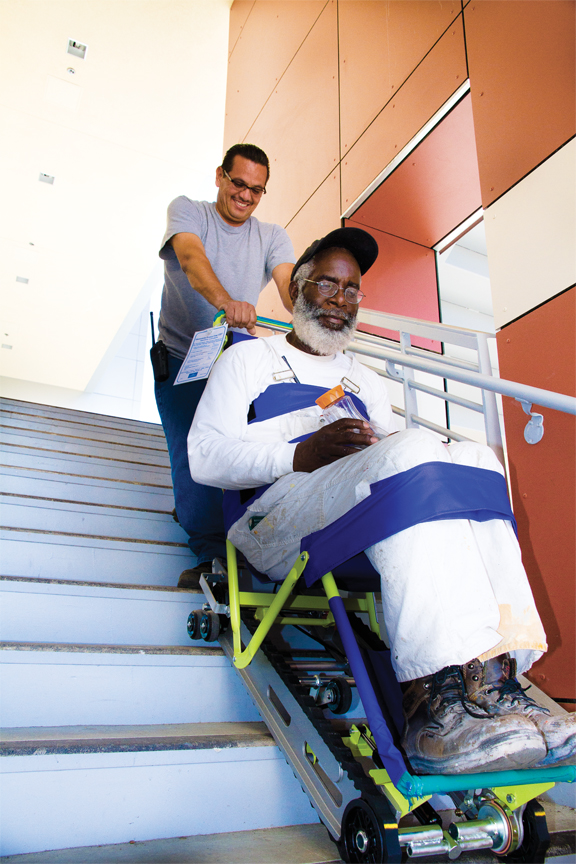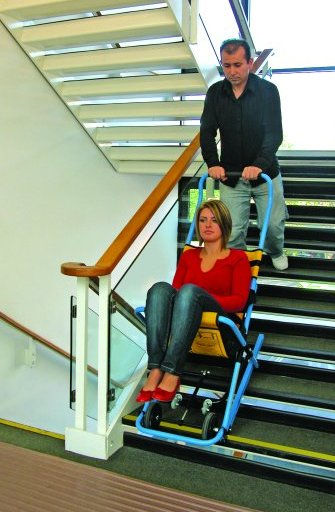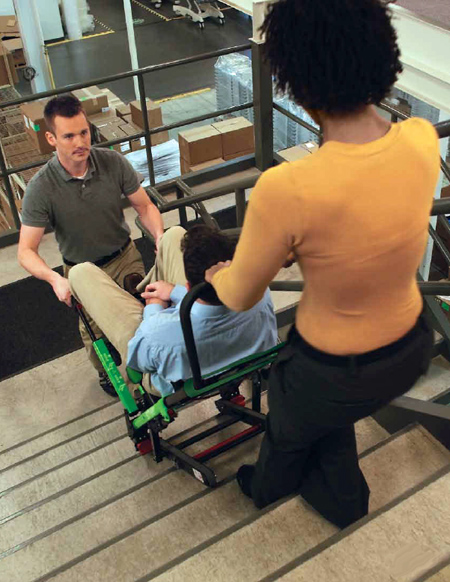Can People with Limited Mobility Use the Usable Circulation Path by Themselves?
Is There a Direct Exit to Grade (or a Ramp)?
A circulation path is considered a usable circulation path if it meets one of the following criteria:
-
A person using a wheelchair is able to travel unassisted through it to a public way (if elevation differences are involved, there are usable ramps rather than stairs).
-
A person using a wheelchair is able to travel unassisted through that portion of the usable circulation path necessary to reach an area of refuge.
An area of refuge serves as a temporary haven from the effects of a fire or other emergency. People with limited mobility must be able to travel from the area of refuge to the public way, although such travel might depend on the assistance of others. If elevation differences are involved, an elevator or other evacuation device might be used, or the person might be moved by another person or persons using a cradle carry, a swing (seat) carry, or an in-chair carry. Training, practice, and an understanding of the benefits and risks of each technique for a given person are important aspects of the planning process.
Special Note 4
Not all people using wheelchairs or other assistive devices are capable of navigating a usable circulation path by themselves. It is important to verify that each person using any assistive device can travel unassisted through the usable circulation path to a public way. Those who cannot must have the provision of appropriate assistance detailed in their emergency evacuation plans. Additionally, the plans should provide for evacuation of the device or the availability of an appropriate alternative once the person is outside the building. Otherwise, the person with limited mobility will no longer have independent mobility once he or she is out of the emergency situation.
Can the Person with Limited Mobility Use Stairs?
Not all people with limited mobility use wheelchairs. Some mobility limitations prevent a person from using building features that require the use of one’s arms, hands, fingers, legs, or feet. People with limited mobility may be able to go up and down stairs easily but have trouble operating door locks, latches, and other devices due to impairments of their hands or arms. The evacuation plans for these people should address alternative routes, alternative devices, or specific provisions for assistance. Are there devices to help people with limited mobility evacuate?
Can the Elevators Be Used?
Although elevators can be a component of a usable circulation path, restrictions are imposed on the use of elevators during some types of building emergencies. Elevators typically return to the ground floor when a fire alarm is activated and can be operated after that only by use of a “fire fighters” keyed switch. This may not be true in the event of non-fire emergencies requiring an evacuation. In the last several years, however, building experts have increasingly joined forces to carefully consider building elevators that are safer for use in the event of an emergency.
In October 2003, the National Institute of Standards and Technology (NIST) began working with the elevator industry to develop and test more reliable emergency power systems and waterproof components. Under consideration are software and sensing systems that adapt to changing smoke and heat conditions, helping to maintain safe and reliable elevator operation during fire emergencies. Such changes could allow remote operation of elevators during fires, thus freeing fire fighters to assist in other ways during an emergency.
The topic was further examined in 2010 during the Workshop on the Use of Elevators in Fires and Other Emergencies cosponsored by the American Society of Mechanical Engineers (ASME International), NIST, the International Code Council (ICC), the National Fire Protection Association (NFPA), the U.S. Access Board, and the International Association of Fire Fighters (IAFF). The workshop provided a forum for brainstorming and formulating recommendations in an effort to improve codes and standards.
The majority of recommendations led to the formation of two new ASME task groups: the Use of Elevators by Fire Fighters task group and the Use of Elevators for Occupant Egress task group, and new code requirements. This work was a collaborative effort of ASME, NIST, ICC, NFPA, IAFF, the U.S. Department of Homeland Security (DHS), and the U.S. Access Board.
Here again, good planning and practice are key elements of a successful evacuation.
Are Lifts Available?
Lifts generally have a short vertical travel distance, usually less than 10 feet, and therefore can be an important part of an evacuation. Lifts should be checked to make sure they have emergency power, can operate if the power goes out, and if so, for how long or how many uses. It is important to know whether the building’s emergency power comes on automatically or a switch or control needs to be activated.
What Other Devices Are Available?
Some evacuation devices and methods, including stair-descent devices, require the assistance of others.






User Comments/Questions
Add Comment/Question